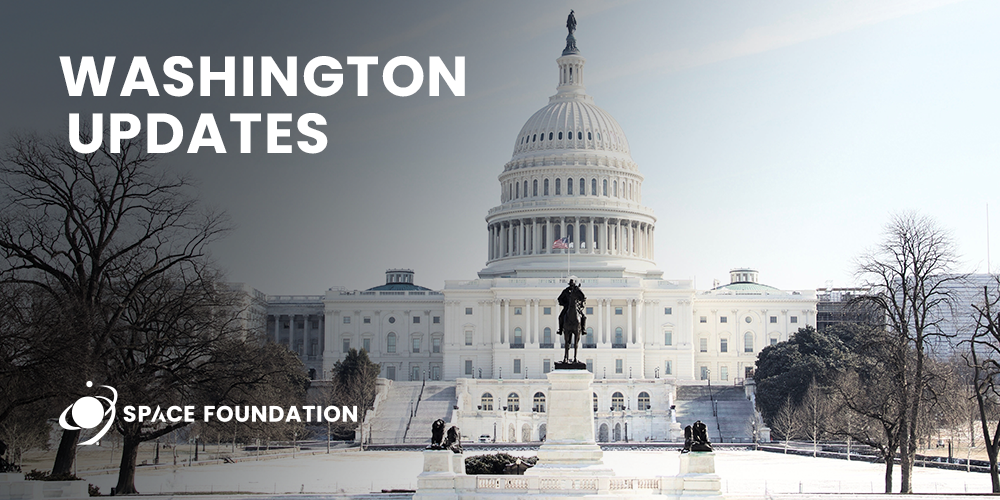International Affairs
Biweekly Washington, D.C. Updates for the Week Ending December 16, 2022
Written by: Elizabeth Anderson

This Month in Washington
This Month in Washington, the NDAA passed through the House, an omnibus deal for FY23 looks to be close for Congress, Space Force celebrated its third birthday, and the Orion spacecraft splashed down in the Pacific Ocean, marking the end of a successful Artemis I mission for NASA.
Space Matters
Space Foundation’s second season of “Space Matters” convenes well-known policy influencers for high-level conversations on emerging topics and trends within the global space economy. Join our expert panelists as they discuss and analyze the latest activities and decisions in the space:
– Artemis Launch
– 2022 Midterm Elections
– Upcoming government funding date for Continuing Resolution
Register for FREE to watch this timely and important program. It’s open to all! Speakers include:
– The Honorable James Bridenstine, Senior Advisor, Acorn Growth Companies
– Ms. Carissa Christensen, CEO and Founder, BryceTech
– Ms. Patricia Cooper, President and Founder, Constellation Advisory, LLC
– The Honorable Robert Walker, CEO, Moon Walker Associates
United States Space Policy Updates
- The White House Office of Science and Technology Policy (OSTP) released the first National Cislunar Science and Technology Strategy (OSTP, November 17)
- The Space Development Agency (SDA) is exploring the inclusion of payloads on future data relay satellites that can provide an alternative to GPS (Breaking Defense, November 21)
- NASA announced plans to cancel the development of its GeoCarb mission and will instead pursue alternate options to measure and observe greenhouse gasses (NASA, November 22)
- The US Space Force activated a new service component command at the US Indo-Pacific Command headquarters in Hawaii (USINDOPACOM, November 23)
- Top Republicans on the House Science Committee urged NASA to prioritize funding for the Near Earth Object (NEO) Surveyor space telescope (US House of Representatives, November 28)
- Gen. Jim Dickinson stated that Space Command (SPACECOM) is considering ways to streamline its decision-making structure, including merging two operational centers (Breaking Defense, November 29)
- French President Emmanuel Macron and Vice President Kamala Harris met to discuss the success of US-France collaboration in space at NASA Headquarters (Via Satellite, November 30)
- Defense Secretary Lloyd Austin established the Office of Strategic Capital to help facilitate partnerships between national security companies and private capital (Department of Defense, December 1)
- Undersecretary of Defense Heidi Shyu established a Defense Science Board task force to examine and make recommendations on the military’s growing demand for commercial space technology (Space News, December 5)
- Bradley Flick was named director of NASA’s Armstrong Flight Research Center in Edwards, California, and Dave Mitchell was named acting director of NASA’s Goddard Space Flight Center in Greenbelt, Maryland (NASA, December 5)
- The United Nations General Assembly voted in favor of a US-led resolution calling for countries to forgo destructive direct-ascent antisatellite (ASAT) tests; several US lawmakers introduced a resolution in support of the global moratorium (Space Policy Online, December 7)
- The House of Representatives passed the National Defense Authorization Act (NDAA), sending the $847 billion measure to the Senate (The Hill, December 8)
- A new report from the Government Accountability Office (GAO) highlights how the government makes use of satellites imagery from the National Reconnaissance Office (NRO) and the National Geospatial-Intelligence Agency (NGA) (GAO, December 8)
International Space Policy Updates
- Hungary to spend $100 million on a private astronaut mission to the International Space Station (ISS) in late 2024 or early 2025 through Axiom Space (Space News,November 23)
- European Space Agency (ESA) Council agreed to increase the agency’s budget by 17 percent at the 2022 Ministerial (ESA, November 23)
- ESA announced a new class of 17 astronauts, the first recruits in 13 years (ESA, November 23)
- China outlined its plans for three upcoming robotic missions to begin construction of the International Lunar Research Station (ILRS) in the 2030s (Space News, November 28)
- Russia launched the final GLONASS-M navigation satellite into orbit aboard Soyuz-2.1b (NASA Spaceflight, November 28)
- The US Space Force plans to stand up a regional command at US Forces Korea Headquarters this year (Chosunilbo, November 28)
- France became the ninth country to sign on to the US-led ASAT testing moratorium during French President Macron’s state visit to Washington DC (White House, November 30)
- Russia and China have signed an intergovernmental agreement to create the International Lunar Research Station (Russian News Agency, December 5)
- Saudi Arabian officials announced that they are in active discussions with other nations to build the next generation of space stations (UAE in Space, December 5)
- Nigeria and Rwanda signed the Artemis Accords, the first and second African countries to do so (Space in Africa, December 13)
- NASA is in negotiations with the UAE to fill gaps in the development of the Lunar Gateway following Russia’s exit (Ars Technica, December 13)
Space Industry Updates
- Boeing reported an additional $195 million charge for the CST-100 Starliner commercial crew program, bringing the total program losses to nearly $900 million (SEC, October 19)
- The US Space Force announced it had ordered three new GPS 3F satellites from Lockheed Martin for $744 million (Space News, November 28)
- The US Space Force Space Systems Command received initial images from the Wide Field of View, a new missile-warning satellite launched in July (Millenium Space Systems, November 29)
- The Federal Communication Commission (FCC) approved part of SpaceX’s application for the second generation of its Starlink constellation, permitting SpaceX to deploy up to 7,500 satellites (FCC, December 1)
- The Department of Defense and the Department of Commerce launched a joint initiative to pilot a new civil space monitoring program (Breaking Defense, December 6)
- Slingshot Aerospace raised $41 million in a Series A2 funding round (Via Satellite, December 6)
- Relativity Space’s 3D-printed rocket Terran 1 has been rolled out to Cape Canaveral Space Force Station (Orlando Sentinel, December 7)
- Astroscale and the Japan Aerospace Exploration Agency (JAXA) announced a partnership to develop an in-space refueling service (Via Satellite, December 7)
- SpaceX launched 40 internet satellites for its competitor OneWeb after Russian Soyuz launches were canceled (CBS News, December 8)
- Collins Aerospace was selected to develop the next generation of International Space Station space suits (Collins Aerospace, December 8)
- Boeing finalized its $3.2 billion deal with NASA for the next generation of Space Launch System (SLS) rockets (Via Satellite, December 12)
Space Leader Spotlight
Dr. Frances Arnold
This week’s chosen spotlight leader is a true idol to women in STEM and all those in the world of science and technology. Dr. Frances Arnold is an accomplished biochemical engineer selected by President Biden to serve as co-chair of the President’s Council of Advisors on Science and Technology. Her career path in engineering started at Princeton University, where she graduated in 1979 with a degree in mechanical and aerospace engineering. Arnold later earned a master’s degree in chemical engineering and completed further postdoctoral work in biophysical chemistry at UC Berkeley.
Arnold is widely recognized for being the first American woman to receive a Nobel Peace Prize in Chemistry after spearheading how to harness evolution and create proteins in 2018. Further, she is the first woman to win the Millennium Technology Prize (2016), and the Charles Stark Draper Prize for Engineering (2011). Impressively, Arnold holds more than 60 US patents and has co-founded three companies in sustainable fuels, chemistry, and agriculture. She is also currently the Linus Pauling Professor of Chemical Engineering, Bioengineering, and Biochemistry at the California Institute of Technology, which manages the Jet Propulsion Laboratory for NASA.
Dr. Arnold’s contribution to the space industry runs deep. Her work has led to the production of enzymes that function in airless environments, enabling the production of biofuels without reliance on expensive air-circulating equipment. She is focused on directing evolution to craft better biofuels, with the ultimate goal of using plant waste or dedicated energy crops to generate significantly fewer greenhouse gasses than gasoline. Overall, Dr. Frances Arnold is a powerhouse in the scientific community and an asset to the PCAST with her ample experience and successes.
Reading Corner
Ars Technica | Bill Nelson came to NASA to do two things, and he’s all out of bubblegum
Eric Berger reflects on his criticism of Senator Bill Nelson’s nomination to serve as NASA Administrator and explains how his assessment was wrong.
Written by Elizabeth Anderson, Megan Wenrich, Amanda Nguyen, and Dana Kenow
Image credits to CBS News

